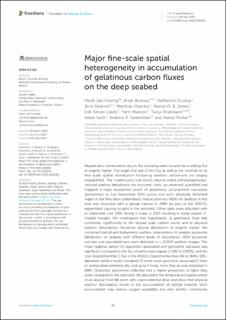| dc.contributor.author | Hoving, Henk-Jan | |
| dc.contributor.author | Boetius, Antje | |
| dc.contributor.author | Dunlop, Katherine Mary | |
| dc.contributor.author | Greinert, Jens | |
| dc.contributor.author | Haeckel, Matthias | |
| dc.contributor.author | Jones, Daniel O. B. | |
| dc.contributor.author | Simon-Lledó, Erik | |
| dc.contributor.author | Marcon, Yann | |
| dc.contributor.author | Stratmann, Tanja | |
| dc.contributor.author | Suck, Inken | |
| dc.contributor.author | Sweetman, Andrew Kvassnes | |
| dc.contributor.author | Purser, Autun | |
| dc.date.accessioned | 2023-10-05T11:09:46Z | |
| dc.date.available | 2023-10-05T11:09:46Z | |
| dc.date.created | 2023-09-14T12:29:05Z | |
| dc.date.issued | 2023 | |
| dc.identifier.citation | Frontiers in Marine Science. 2023, 10 . | en_US |
| dc.identifier.issn | 2296-7745 | |
| dc.identifier.uri | https://hdl.handle.net/11250/3094459 | |
| dc.description.abstract | Abyssal plain communities rely on the overlying water column for a settling flux of organic matter. The origin and rate of this flux as well as the controls on its fine-scale spatial distribution following seafloor settlement are largely unquantified. This is particularly true across regions where anthropogenically-induced seafloor disturbance has occurred. Here, we observed, quantified and mapped a mass deposition event of gelatinous zooplankton carcasses (pyrosomes) in July-September 2015 across one such physically disturbed region in the Peru Basin polymetallic nodule province (4150 m). Seafloor in this area was disturbed with a plough harrow in 1989 (as part of the DISCOL experiment) causing troughs in the sediment. Other parts were disturbed with an epibenthic sled (EBS) during a cruise in 2015 resulting in steep-walled, U-shaped troughs. We investigated two hypotheses: a) gelatinous food falls contribute significantly to the abyssal plain carbon pump and b) physical seafloor disturbance influences abyssal distribution of organic matter. We combined optical and bathymetric seafloor observations, to analyze pyrosome distribution on seabeds with different levels of disturbance. 2954 pyrosome colonies and associated taxa were detected in > 14,000 seafloor images. The mean regional carbon (C) deposition associated with pyrosome carcasses was significant compared to the flux of particulate organic C (182 to 1543%), and the total respired benthic C flux in the DISCOL Experimental Area (39 to 184%). EBS-disturbed seafloor tracks contained 72 times more pyrosome-associated C than an undisturbed reference site, and up to 4 times more than an area disturbed in 1989. Deposited pyrosomes collected had a higher proportion of labile fatty acids compared to the sediment. We document the temporal and spatial extent of an abyssal food fall event with unprecedented detail and show that physical seafloor disturbance results in the accumulation of detrital material. Such accumulation may reduce oxygen availability and alter benthic community structure. Understanding both the relevance of large food falls and the fine scale topography of the seafloor, is necessary for impact assessment of technologies altering seafloor integrity (e.g. as a result of bottom-trawling or deep seabed mining) and may improve their management on a global scale. | en_US |
| dc.language.iso | eng | en_US |
| dc.title | Major fine-scale spatial heterogeneity in accumulation of gelatinous carbon fluxes on the deep seabed | en_US |
| dc.title.alternative | Major fine-scale spatial heterogeneity in accumulation of gelatinous carbon fluxes on the deep seabed | en_US |
| dc.type | Peer reviewed | en_US |
| dc.type | Journal article | en_US |
| dc.description.version | publishedVersion | en_US |
| dc.source.pagenumber | 17 | en_US |
| dc.source.volume | 10 | en_US |
| dc.source.journal | Frontiers in Marine Science | en_US |
| dc.identifier.doi | 10.3389/fmars.2023.1192242 | |
| dc.identifier.cristin | 2175079 | |
| dc.relation.project | Norges forskningsråd: 244646 | en_US |
| cristin.ispublished | true | |
| cristin.fulltext | original | |
| cristin.qualitycode | 1 | |
